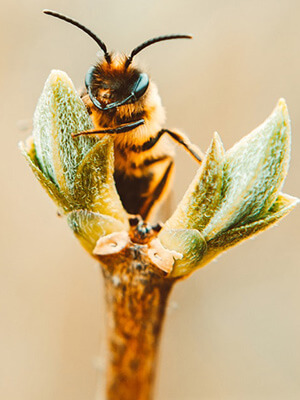Manufacturers and their suppliers have understood for a few years now that sustainability is a foundational aspect of their operations, but for the most part sustainability was overgeneralized as simply “being green”. Today, however, industry has recognized the importance of biodiversity as a cornerstone of sustainability and are working to have an impactful and positive influence in the biodiversity of their local habitats. In fact, there are now a number of organizations and groups that are actively working to measure, monitor, and improve biodiversity.
The Vital Importance and Decline of Pollinators
Pollinators have become a strong focus of sustainability and biodiversity efforts within the automotive manufacturing industry, and for good reason: pollinators are some of the most dynamic and important groups in our entire planetary food cycle. Pollinators are responsible for the reproduction of so many of our fruits, vegetables, and other plants, as well as producing honey and other beneficial materials.
Unfortunately, pollinators are also facing some of the most alarming population drops in history, with both monarch butterflies and Rusty Patched Bumblebees being added to the endangered species list – in addition to the steep decline in other types of pollinating bees.
There are numerous reasons why pollinators populations are suffering – including human activities, use of pesticides, and loss of habitat.
Is Biodiversity Important for Your Business?
So you might now be asking… should my business be taking on a biodiversity project?
We think the answer is yes – in fact, we believe that biodiversity is one of the most effective places to kickstart your business’s larger sustainability program. Biodiversity can incorporate large and small projects and is usually easier for employees to understand than some more complex sustainability initiatives.
For example, planting a pollinator garden on site is an easy and affordable project that employees will likely be proud of and enjoy contributing to. All it takes is a little research into pollinator-friendly flowers and some space on your site.
We want to share a case study of a larger-scale biodiversity project that might spark your sustainability-thinking.
Industry Taking Action: Project Wingspan
There are industry groups stepping in to take action to try and reverse the downwards trend for pollinator species, and the automotive industry is notably among them. One that we want to highlight in this article is the Supplier’s Partnership for the Environment (SP), a group of the top automotive OEMs and their suppliers, working side by side to introduce best practices and projects for the entire industry.
The Supplier’s Partnership has joined hands with the Pollinator Partnership (P2), as well as the Wildlife Habitat Council, to launch Project Wingspan.
Project Wingspan (https://pollinator.org/wingspan) is a joint project to increase the habitat of monarch butterflies and rusty patch bumblebees to an established 10,000 acres across the states of Arkansas, Illinois, Indiana, Michigan, Missouri, Ohio, Pennsylvania, and Wisconsin. A significant portion of this land is privately managed by facilities in the automotive Supplier’s Partnership.
The Suppliers Partnership is committed to enhancing the habitat and minimizing their environmental impact through implementing new manufacturing best practices and spearheading numerous sustainability projects.
In fact, ERA has partnered with The Pollinator Partnership (P2), the Wildlife Habitat Council, and the Supplier’s Partnership for the Environment (SP) to help with the collection, processing, and reporting of these sustainability efforts.
Data-Driven Biodiversity: Measuring and Managing Habitat
Biodiversity is complex and intricate: almost every element of a habitat’s health is interconnected with numerous other data points. It’s impossible to measure every possible aspect – but it is equally important to start somewhere.
Project Wingspan focuses its efforts on:
- The distribution of the eastern monarch population;
- And the native growth distribution of pollinator-friendly plants such as common milkweed, swamp milkweed, butterfly weed, and showy milkweed.
These would be the data points that the SP members would prioritize, and where ERA’s sustainability mapping and workflows would be implemented. ERA first organized the location data from SP members’ facility coordinates, and helped establish goals of increasing the quality, quantity, and connectivity of pollinator habitats across these areas, as well as to increase interest and skill in seed collection from the varieties of milkweed identified by the Pollinator Partnership.
By viewing this data alongside the monarch’s migratory pathways, this help the SP members prioritize actions and areas – without good data from the pollinator groups and from land managers, this activity would be much more difficult to understand holistically and more difficult to manage.
The Importance and Challenge of Data Collection
Biodiversity stewardship is a science, and it needs good data to drive it forward.
And just as biodiversity is an interconnected web, so is biodiversity management, especially when it is done collaboratively.
In Project Wingspan, data is being sourced from Supplier Partnership member manufacturers, the Pollinator Partnership, and environmental experts on each affected species. Each of these groups speaks a different language and tracks data differently, making it even more important to have a common ground to work from.
ERA Environmental acts as that common ground by being a repository for all of the data from each of these groups – centralizing and standardizing it so that analysis can be done and conclusions can be drawn.
These same challenges can apply to your own biodiversity projects; if you are working with local conservationists, or have multiple departments collaborating on a common sustainability goal, having good data from multiple sources can take extra effort:
- Agree on specific data points to prioritize and how to measure them.
- Establish standards on how to measure and record that data.
- Have one place to share and store that data where all stakeholders can access it.
These guidelines are enforced by using a sustainability tracking software like ERA’s.
Conclusion: Next Steps for You Biodiversity Project
So you’ve seen what a large-scale biodiversity project can look like and the importance of data management. You might now be wondering how you can get involved or what your next step should be.
The Pollinator Partnership has an extensive learning center full of resources for any type of business or individual who wants to protect and enhance the habitat of local pollinators: https://pollinator.org/learning-center. It’s a great resource for getting started.
Some successful pollinator projects that ERA has been a part of include:
- Hosting beehives on your facility – many cities have beekeeping groups that provide the material and work in exchange for space on your property.
- Planting pollinator-friendly flower gardens on site.
- Eliminating the use of pesticides from your grounds maintenance or changing your groundskeeping policies.
- Installing at houses on site (yes, bats are excellent pollinators as well).
Make sure whatever project you choose to start with also prioritizes data collection and analysis – without data you cannot fully understand or improve your impact. Data is what turns a “feel-good” biodiversity project into a measurable and meaningful difference.
This blog was co-authored by:


Tags:
Sustainability
April 23, 2019


Comments